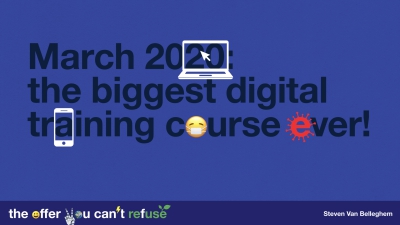How Customer Experience is changing the healthcare industry

Research by Salesforce showed that no less than 47% of consumers say that healthcare and life sciences are more focused on industry needs than patient needs. A study from PwC shows that only 49% of consumers say that the healthcare customer experience is satisfactory. It’s safe to say that health-related organizations, ranging from insurers to pharmaceutical companies, are not really perceived as the most customer centric. Which is a true tragedy when we think about how much we will need this industry to help us solve the huge problems of a growing and ageing population and the COVID-like pandemic crises that await us in the future.
No wonder that this is one of the sectors that is so much being disrupted by some clever giants from the tech industry – Apple, Amazon, Google, Uber – who do know how to put the customer in the center of their offering. They have been the ones to set the bar in customer expectations and a most healthcare companies have a lot to learn from them.
An important change would be to stop viewing patients as needy and docile but rather as empowered, critical and tech savvy consumers that need to be wooed with flawless experiences. An important ingredient of that will be to move out of the negative emotions sphere of pain, worry and fear that come with sickness and start to protect health instead of managing disease, moving from sickcare to proactive healthcare experiences. Anticipating problems and solving them before they bother the patient-customer will become the new norm. A simple but great example of that are for instance insurers like Vitality and Medibank LiveBetter that have started promoting well-being and healthy living.
The way I see it, healthcare players will need to focus on these three main points of attention if they want to offer the customer experience needed to survive in their increasingly disrupted industry:
- Erasing friction
- Converging into platforms and ecosystems
- Hyper-personalization
Erasing friction
I have said before that COVID-19 was the greatest digitization test that mankind has ever experienced, especially in healthcare. Not only is telehealth – removing the frictions of travel and waiting time – starting to thrive but many new solutions to track health and measure data – removing the friction of disease itself – have surfaced. The good news is that the more healthcare is digitized, the more data becomes available and the smarter the solutions will become.
Healthcare is still one of the most friction-riddled industries, which is one of the main reasons of its low popularity. The good news is that every friction is an opportunity for innovation, so my concept of “friction hunters” (employees who find and tackle customer frictions) would be extremely relevant here. If you work in healthcare, I would suggest that you try to solve them one by one, as there are a lot of technologies available for that. This could be very simple like offering easier ways to book an appointment or check in, reducing waiting times, getting test results without seeing a doctor or 24/7 access to the health information and care.
One of the biggest frictions in healthcare in the US is for instance a pricing so high that it becomes unaffordable for many people. So Walmart found a way to offer cheaper basis services through its smaller Care Clinics and larger Walmart Health center. I also love how the Harvard Medical School hospital helps diagnose and treat patients more quickly with Buoy Health’s chatbot: it listens to a patient’s symptoms and health concerns, then guides that patient to the correct care based on its diagnosis. Johns Hopkins Hospital has a partnership with GE to use predictive AI techniques to improve the efficiency of patient operational flow; resulting in a 60% improvement in its ability to admit patients and a 21% increase in patient discharges before noon, resulting in a faster, more positive patient experience. The startup Babylon Health uses AI to provide personalized and interactive healthcare, including anytime face-to-face appointments with doctors.
There are many ways that technology can make the patient journey a lot smoother and more frictionless. But the biggest effect is of course that freeing up the tedious and repetitive tasks of healthcare workers, will allow them to focus on the human side. Olive’s AI platform, for instance, is exactly designed to automate the healthcare industry’ most repetitive tasks, freeing up administrators to work on higher-level ones. It automates everything from eligibility checks to un-adjudicated claims and data migrations so staffers can focus on providing better patient service.
An important part of making this transition to a more human approach, unrelated to reducing friction for the patient and time for the healthcare worker, is improving the employee experience as well. Healthcare is an industry where a lot of workers are overstressed, overworked and underpaid. And if those frontline workers are not happy themselves, you’ll know that they will have a really hard time to make the customer happy, who’s often overstressed himself. Improving employee experience could make a huge difference here.
Platforms and ecosystems
One of the biggest impediments for offering a fantastic customer experience in healthcare is often the lack of a full view of the customer. Different physicians, for example, will have different data about the health of their patients and will lack a holistic picture. Or pharmacies, even those that are part of the same chain, only have access to medications bought from a particular location by that patient. But it’s not just the healthcare workers, patients too are in need of a unified location for all information about their health.
For that, healthcare players will need to converge their services as well as start gathering in ecosystems, even working across other industries with for instance health tech providers. And we see that happening everywhere. In 2019, Google’s health company Verily for instance announced that it was forming alliances with some of the largest pharmaceutical players in the world like Novartis, Sanofi, Otsuka and Pfizer. Sanofi and Verily have joined forces at OnDuo to tackle diabetes, while Roche acquired MySugr to become the leading open platform in diabetes management. Philips is partnering with Salesforce to extend their HealthSuite digital platform. Good Doctor, then, is a platform from Chinese insuring company Ping An that connects doctors and patients for bookings, online diagnoses, and suggested treatments. The platform had signed up over 3,000 hospitals and over 15,000 pharmacies in a record time. It now also operates a one-hour drug delivery service in almost 100 Chinese cities.
The Apple Healthkit is another fantastic example of such an ecosystem and platform evolution: their app has a set of APIs that allow mindfulness apps, fitness apps, activity trackers, blood-pressure or glucose monitors, or nutritional apps to streamline all the relevant health-related information into the Apple platform. The result is an open digital ecosystem platform which brings together all sorts of participants from across the world of medicine: from physicians, researchers, hospitals, and patients to developers of healthcare and fitness applications. All this data will allow the Apple platform to play a significant role in the development of new medicines, in treatments, or in insurance. Above all, it offers its users a fantastic experience of monitoring their health in a centralized place.
Hyper-personalization
But of course, the best way to offer a fantastic customer experience is by making the experience so personal and know the customer so well that (s)he no longer needs to become ill.
One important way to offer hyper personalization is of course by analysing a person’s DNA, which allows healthcare providers to tailor medication doses and therapies to their personal DNA profile, on top of identifying hereditary conditions or diagnose cancers early. In Australia, for instance, DNAfit offers genome-personalized workout and nutrition advice including diet plans, grocery lists, and a workout app that creates routines based on your genetic muscle type, endurance level and risk of injury.
But platforms like the Apple Healthkit described above will also play a huge role in personalizing healthcare for the customers, because the more data can be centralized, compared and mined, the more tailored the user experience will become. Chicago start-up Tempus, for instance, is using AI to allow doctors to filter “the world’s largest collection of clinical and molecular data” – from genetic sequencing to image recognition – in order to personalize healthcare treatments. It is currently using its AI to the benefit of cancer research and treatment. The Cleveland Clinic, then, teamed up with IBM to use AI to gather information on trillions of administrative and health record data points to streamline the patient experience and personalize healthcare plans on an individual basis. London startup BenevolentAI is trying to offer the right treatment to the right patients at the right time by using artificial intelligence to produce a better target selection and provide previously undiscovered insights through deep learning.
ICarbonX might be my favorite example in the matter, though. I’ve visited them many times during our nexxworks Innovation Programs, and each time I do, they blow me away with their ambitious and holistic vision. Yingrui Li, their Chief Scientist told us that they want to “create a mathematical model for human health and get rid of disease”. They want to build a consumer-facing AI platform as a one-stop shop for all things health and wellness, forming a “digital health alliance” with startups across the globe: from skincare and nutrition recommendations to behavioral health and genetic analysis and even health and life insurance. You could say that they have an Amazon-for-health approach: the platform is not one singular product, but an ecosystem of health services through which all other applications are connected. It is exactly this combination of massive data sets, biotechnology, and artificial intelligence which will allow them to offer highly individualized care as well as an approach that is highly proactive at preventing disease.
Highly personalized, health stimulating and disease-preventing one-stop-shop approaches like these are a perfect way for healthcare players to become a ‘Partner in the Life’ of their customers, which I believe that companies will need to become if they want to stay relevant and become An Offer You Can’t Refuse (my new book that will be released in September 2020).
Customer Experience in healthcare has come a long way. On the other hand, reading from its low popularity, there is still a lot of room for improvement, as I mentioned in the opening lines. But ever the optimist, I prefer to look at these challenges and frictions as an excellent opportunity for innovation and new business. I hope that they will trigger you too.

